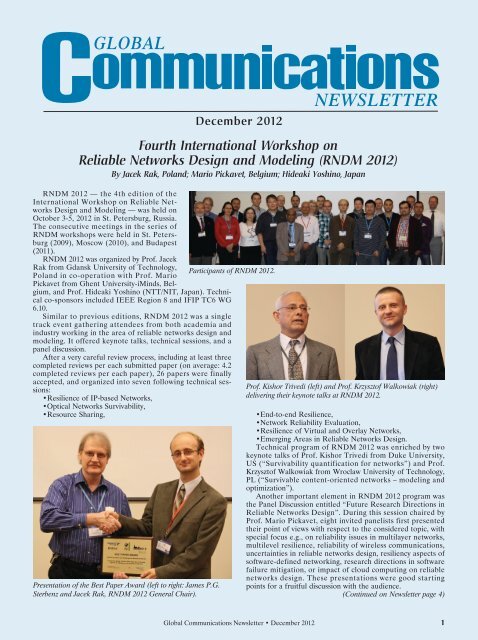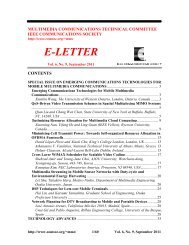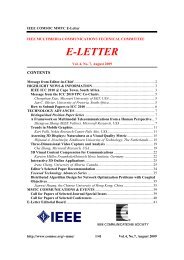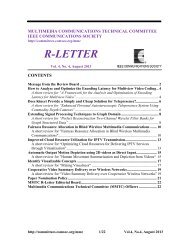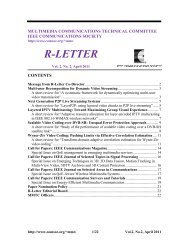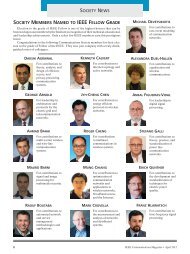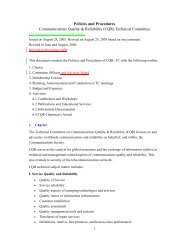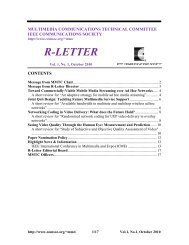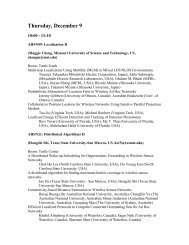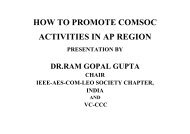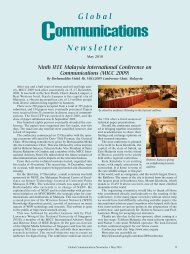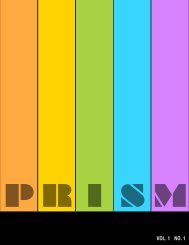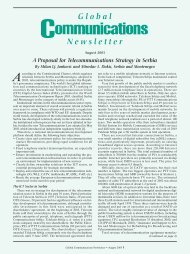December - IEEE Xplore
December - IEEE Xplore
December - IEEE Xplore
Create successful ePaper yourself
Turn your PDF publications into a flip-book with our unique Google optimized e-Paper software.
GLOBAL<strong>December</strong> 2012NEWSLETTERFourth International Workshop onReliable Networks Design and Modeling (RNDM 2012)By Jacek Rak, Poland; Mario Pickavet, Belgium; Hideaki Yoshino, JapanRNDM 2012 — the 4th edition of theInternational Workshop on Reliable NetworksDesign and Modeling — was held onOctober 3-5, 2012 in St. Petersburg, Russia.The consecutive meetings in the series ofRNDM workshops were held in St. Petersburg(2009), Moscow (2010), and Budapest(2011).RNDM 2012 was organized by Prof. JacekRak from Gdansk University of Technology,Poland in co-operation with Prof. MarioPickavet from Ghent University-iMinds, Belgium,and Prof. Hideaki Yoshino (NTT/NIT, Japan). Technicalco-sponsors included <strong>IEEE</strong> Region 8 and IFIP TC6 WG6.10.Similar to previous editions, RNDM 2012 was a singletrack event gathering attendees from both academia andindustry working in the area of reliable networks design andmodeling. It offered keynote talks, technical sessions, and apanel discussion.After a very careful review process, including at least threecompleted reviews per each submitted paper (on average: 4.2completed reviews per each paper), 26 papers were finallyaccepted, and organized into seven following technical sessions:•Resilience of IP-based Networks,•Optical Networks Survivability,•Resource Sharing,Participants of RNDM 2012.Prof. Kishor Trivedi (left) and Prof. Krzysztof Walkowiak (right)delivering their keynote talks at RNDM 2012.•End-to-end Resilience,•Network Reliability Evaluation,•Resilience of Virtual and Overlay Networks,•Emerging Areas in Reliable Networks Design.Technical program of RNDM 2012 was enriched by twokeynote talks of Prof. Kishor Trivedi from Duke University,US (“Survivability quantification for networks”) and Prof.Krzysztof Walkowiak from Wroclaw University of Technology,PL (“Survivable content-oriented networks – modeling andoptimization”).Another important element in RNDM 2012 program wasthe Panel Discussion entitled “Future Research Directions inReliable Networks Design”. During this session chaired byProf. Mario Pickavet, eight invited panelists first presentedtheir point of views with respect to the considered topic, withspecial focus e.g., on reliability issues in multilayer networks,multilevel resilience, reliability of wireless communications,uncertainties in reliable networks design, resiliency aspects ofsoftware-defined networking, research directions in softwarefailure mitigation, or impact of cloud computing on reliablenetworks design. These presentations were good startingpoints for a fruitful discussion with the audience.Presentation of the Best Paper Award (left to right: James P.G.Sterbenz and Jacek Rak, RNDM 2012 General Chair). (Continued on Newsletter page 4)Global Communications Newsletter • <strong>December</strong> 20121
Highlighted Activities from the<strong>IEEE</strong> NZ Communications Society Chapter 2012By Nurul I Sarkar, Chair of <strong>IEEE</strong> Joint New Zealand North & South ComSoc ChapterThe <strong>IEEE</strong> New Zealand CommunicationsSociety (ComSoc) is a jointchapter of NZ North and South Sections.There is another ComSoc/Sig-Pro Chapter in the NZ CentralSection. <strong>IEEE</strong> NZ Wireless Workshopis one of the main activities ofour society for professional developmentof the members of the Societyand the wider community. The WirelessWorkshops are organised by thewireless research community of NewZealand, and have been held annuallysince 1998. The venues rotatebetween Auckland, Wellington andChristchurch. The events are normallyheld in late August or early September when most ofthe NZ Universities observe their mid-semester break.The University of Canterbury (Christchurch) hosted lastyear’s event and was proceeded despite of the serious earthquakeearlier in the year. This year’s event was held in Aucklandon Friday 31st August 2012 organised by AucklandUniversity of Technology (AUT). This annual event broughttogether more than 65 engineers, researchers, industrialistsand policy makers working in the field of wireless communicationsand network technologies. People came all the way fromSouthland/Invercargill (south of South Island) to far north ofAuckland covering the whole country.The day consists of a series of presentations from participants,including keynote, industry, wireless research centre,and academy presentations with ample opportunity for informaldiscussion and networking. As always this event coveredvarious topics and provided a forum for experts in the wirelessindustry and academia to discuss innovative technologies andresearch currently being undertaken. The idea is to provide aforum for innovative engagement and networking betweenacademy and industry.Professor Abbas Jamalipour (1st keynote speaker) is addressinghis keynote talk on “Smart Grid Communications”.Sudhir Singh (2nd keynote speaker) is giving his presentation on“Convex optimisation for communications systems”.2012 <strong>IEEE</strong> NZ Wireless Workshop Attendees (photo by Akbar Hossain).The workshop had two excellent keynote speakers - ProfessorAbbas Jamalipour (University of Sydney) and SudhirSingh (Industrial Research Limited). Professor Jamalipourgave an interesting presentation on “Smart Grid Communications”and its future development. He highlighted the opportunityfor wireless communication researchers to contribute inthis exciting field. The second keynote speaker Mr Singhfocused on Wireless Systems Optimization techniques usinganalytical modelling and its potential applications in communications.Among the industry participants, John Yaldwyn (foundingdirector of 4RF Limited) gave a fantastic presentation oninnovation and regulation in the RF market. He highlightedthe innovative activities currently undertaken by 4RF limitedincluding high capacity transmitter design for land mobileradio services.Dylan Jorgensen (AVIAT NETWORKS Limited) gave aninteresting talk on the recent development of high frequencyterrestrial microwave communication technologies. He arguedthat terrestrial microwave communications can be very effective(e.g. lower delay) in linking US major cities than othertechnologies such as optical networks.Rahul Mehta (Ministry of Economic Development) highlightedthe recent developments of radio spectrum planningand management in New Zealand. He answered some of thekey questions related to radio spectrum allocation for commercialprograms such as digital TV and other communications.NZi3 wireless research centre (WRC) is a national researchcentre located at the University of Canterbury (Christchurch).Three key researchers, namely Nicholas Pau, Gayathri Kongara,and Sasha Wang from NZi3 WRC highlighted theirresearch activities. Nicholas Pau gave a short presentation on“When can interference be modelled as noise in LTE systems”.Gayathri Kongara talked about “Capacity enhancingtechniques for MIMO systems”, and Sasha Wang highlightedforward error correction coding techniques for broadcast communicationsystems. The summary of the recent findings arealso presented reflecting the quality of research work carriedout at WRC in recent years. Some of the research projectsundertaken at the NZi3 are commercial in nature sponsoredby industry.The various wireless research groups around the country,including University of Canterbury, Massey University, VictoriaUniversity of Wellington, University of Auckland, AUTUniversity and Manakau Institute of Technology gave minipresentations highlighting their current research activities.(Continued on Newsletter page 4)2Global Communications Newsletter • <strong>December</strong> 2012
Distinguished Lecturer Tours of Falko Dressler, Nsir Memon andNarayan Mandayam in IndiaBy Prof. Deergha Rao Korrai, Chair of the Communications and Signal Processing Societies Joint Chapter,Hyderabad, IndiaThree Distinguished Lecturer Tours were held in India inAugust and September 2012 by Falko Dressler, Nsir Memonand Narayan Mandayam.DLT of Falko DresslerThe Distinguished Lecturer tour of Dr. Falko Dressler,Professor,Institute of Computer Science, University of Innsbruck,Austria, was held in India during August 2012 with the followingschedule:•Pune, 6th & 7th August 2012(two lectures); on ‘Protocol Engineeringfor Vehicular Communications’ ’ and Biologicallyinspiredand Nano-scale Communication and Networking’.•Hyderabad, 8th August 2012 (One lecture); on ‘Protocol Engineeringfor Vehicular Communications’.The <strong>IEEE</strong> Communications Society has funded the DLT ofDr.Dressler. In the lecture on Biologically-inspired and NanoscaleCommunication and Networking , Dr.Dressler has presentedthe existing bio-inspired networking and communicationprotocols and algorithms devised by looking at biology as asource of inspiration, and by mimicking the laws and dynamicsgoverning these systems along with open research issues for thebio-inspired networking. Furthermore, he has linked thedomain of bio-inspired networking to the forthcoming researchdomain of nano networks, which will bring a set of unique challengesDuring the lecture on ‘Protocol Engineering for VehicularCommunication’ , Dr.Dressler has introduced the recent developmentsin the field of IVC protocols and the used methods.He has discussed inparticular the possible approaches to IVCbased on flooding, peer-to-peer techniques, and periodic beaconing.Further, he has elaborated the investigations on theevolution of simulation techniques and how recent advances inbidirectional coupling of road traffic microsimulation and networksimulation lead to more realistic results at comparably lowcomputational cost.Audience during the lecture of Nasir Memon at NERTU, OsmaniaUniversity, Hyderabad on 23 August 2012.DLT of Nasir MemonThe Distinguished Lecturer tour of Dr.Nasir Memon, <strong>IEEE</strong>Fellow, Professor, Polytechnic Institute of New York University,U.S.A, was held in India during August 2012. with the followingschedule:•Bangalore, 21st August 2012(one lecture); on ‘RecentAdvances in Image Forensics’.•Hyderabad, 23rd &24th August 2012 (two lectures); on ‘BiometricRich Gestures: A Touching Farewell to Passwords’and ‘Recent Advances in Image Forensics’.The <strong>IEEE</strong> Signal Processing Society has funded the DLT ofDr. Memnon. The lecture at Bangalore was organized by theSignal Processing chapter of the <strong>IEEE</strong> Bangalore Section. Thelecture at Bangalore on ‘Biometric Rich Gestures: A TouchingFarewell to Passwords’ was held in the Indian Institute of Science.Dr. Memon’s lectures in Hyderabad were organized by theCommunications and Signal Processing Societies Joint Chapterof the <strong>IEEE</strong> Hyderabad Section. The lecture on ‘RecentAdvances in Image Forensics’ is tuned to a tutorial which isheld on 23 August 2012 at Research and Training Unit for NavigationalElectronics (NERTU) auditorium, University Collegeof Engineering, Osmania University, Hyderabad from 2P.M to5.30PM. The audience for the tutorial are 34(Thirty four)including students, Research scholars, and faculty from engineeringcolleges.In this tutorial, Dr Memon has overviewed recent developmentsin the field of forensics, focusing on three problems.First, collecting image evidence and reconstructing them fromfragments, with or without missing pieces. This involves sophisticatedfile carving technology. Second, attributing the image toa source, be it a camera, a scanner, or a graphically generatedpicture. The process entails associating the image with a class ofsources with common characteristics (device model) or matchingthe image to an individual source device, for example a specificcamera. Third, attesting to the integrity of image data. Thisinvolves image forgery detection to determine whether animage has undergone modification or processing after being initiallycaptured.The lecture on ‘Biometric Rich Gestures: A TouchingFarewell to Passwords’ is held on 24 August 2012 at the IndianInstitute of Technology, Hyderabad from 3.30PM to 5PM. Theaudience for this lecture are 32(thirty two) including students,Research scholars, and faculty from IIT, Hyderabad..During the lecture, he has stated that multi-touch interfacesallow users to have a very intuitive, tactile and visual interactionwith a computing device by touching a surface with their fingerswith gestures that resemble interaction with real life objects.The development of multi-touch technology opens up avenuesfor new authentication techniques that go beyond text passwords.He has discussed gesture based authentication alternativesthat are both engaging and pleasing to the users whileproviding strong security.DLT of Narayan MandayamThe Distinguished Lecturer tour of Dr. Narayan Mandayam,<strong>IEEE</strong> Fellow, Professor, Rutgers University, U.S.A, was held inIndia during September 2012. with the following schedule:•Bangalore, 21stSeptember 2012(one lecture); on ‘NetworkCoding as a Dynamical System’.•Pune, 24th & 25th September 2012 (two lectures) on ‘TowardsGreen Techniques for Wireless Communications’ and ‘NetworkCoding as a Dynamical System’.•Hyderabad, 26th September 2012 (two lectures); on ‘TowardsGreen Techniques for Wireless Communications’ and ‘NetworkCoding as a Dynamical System’.(Continued on Newsletter page 4)Global Communications Newsletter • <strong>December</strong> 2012 3
DISTINGUISHED LECTURERS/continued from page 3The <strong>IEEE</strong> Communications Society has funded the DLT ofDr. Narayan. His lecture on ‘Towards Green Techniques forWireless Communications’ at Hyderabad was held on 26September 2012 from 10.30am to 12 noon at Imagination Technologies,Banjara Hills, Hyderabad and the talk on ‘NetworkCoding as a Dynamical System’ was held from 4.30pm to 6pm .at Research and Training Unit for Navigational Electronics(NERTU) auditorium, University College of Engineering,Osmania University, Hyderabad 80participants have attendedthese lectures.During his talk on ‘Towards Green Techniques for WirelessCommunications’, Dr.Narayan has first identified the techniquesaffording power savings in cellular systems and further presentednew energy efficient radio resource management approachesmotivated by two considerations: (1) the fundamental tradeoffbetween the marginal utility of power and the marginal utility ofbandwidth in power and bandwidth constrained systems; and (2)the advent of dynamic spectrum access (DSA) techniquesafforded by cognitive radio and noncontiguous OFDM technologyIn the lecture on ‘Network Coding as a Dynamical System’,Dr.Narayan has outlined a framework based on differentialequations that allows modeling of the dynamics of wireless networkcoding and enables the design of cross-layer radio resourceallocation algorithmsNZ CHAPTER ACTIVITIES/continued from page 2Some of the research students (Masters and PhD) in thegroup also presented their research findings.Overall, it was a productive day for the workshop attendeesas far as presentations, academy-industry link, and sharingideas are concerned. People have enjoyed the facilities providedby AUT University and have had talking/networking duringmorning tea, lunch, and afternoon tea.The event was co-sponsored by <strong>IEEE</strong>, 4RF Limited, Spe-cialist Rentals Limited, and AUT University. The ComSocChapter Chair (joint NZ North and South) Associate ProfessorNurul Sarkar received positive feedback from the attendeesindicating that it was a highly successful event which wasbeautifully managed by Network and Security Research Groupat AUT. The next year’s Workshop will be hosted by VictoriaUniversity of Wellington.In addition to hosting <strong>IEEE</strong> NZ Wireless Workshop inrecent weeks, we have also organized <strong>IEEE</strong> ComSoc DL Tourto New Zealand. Professor Koichi Asatani (from Japan) hasagreed to come and deliver his DL talks in Auckland,Christchurch and Wellington on November 19, 21 and 23,respectively. <strong>IEEE</strong> DLs are very high profile people in theirfield of specialization worldwide, and Professor Asatani’s visitto New Zealand will enhance international networking opportunityfor members of the society and the wider community.RNDM 2012/continued from page 1Ceremony of Best Paper Award took place during the closingsession. This time the award was given to the paper “Modellingattacks and challenges to wireless networks” byDongsheng Zhang (US), Santosh Ajith Gogi (US), Dan S.Broyles (US), Egemen K. Cetinkaya (US), and James P.G.Sterbenz (US, UK).A special issue of Telecommunication Systems Journal(Springer) for extended versions of selected highest-qualityRNDM 2012 papers is currently under preparation.Based on feedback from participants, we are convinced thatRNDM 2012 was a very successful event with valuable contentsbeing presented. As a proof of that, all technical sessionswere highly attended (each time over 80% of attendanceratio). Also, we were extremely satisfied to notice that RNDM2012 was the next event in the series of RNDM workshopswith 100% of papers being presented (i.e., without “noshows”).The next edition of RNDM will take place in Almaty,Kazakhstan, on 10–13 September, 2013. More informationmay be found at http://www.rndm.pl.GLOBALNEWSLETTERwww.comsoc.org/gcnSTEFANO BREGNIEditorPolitecnico di Milano - Dept. of Electronics and InformationPiazza Leonardo da Vinci 32, 20133 MILANO MI, ItalyPh.: +39-02-2399.3503 - Fax: +39-02-2399.3413Email: bregni@elet.polimi.it, s.bregni@ieee.org<strong>IEEE</strong> COMMUNICATIONS SOCIETYNELSON FONSECA, VICE-PRESIDENT MEMBER RELATIONSPEDRO AGUILERA, DIRECTOR OF LA REGIONYIGANG CAI, DIRECTOR OF NA REGIONFAMBIRAI TAKAWIRA, DIRECTOR OF EAME REGIONKWANG BOK LEE, DIRECTOR OF AP REGIONROBERTO SARACCO, DIRECTOR OF SISTER AND RELATED SOCIETIESREGIONAL CORRESPONDENTS WHO CONTRIBUTED TO THIS ISSUEEWELL TAN, SINGAPORE ALEXEY VINEL, FINLAND ®A publication of the<strong>IEEE</strong> Communications Society4Global Communications Newsletter • <strong>December</strong> 2012


